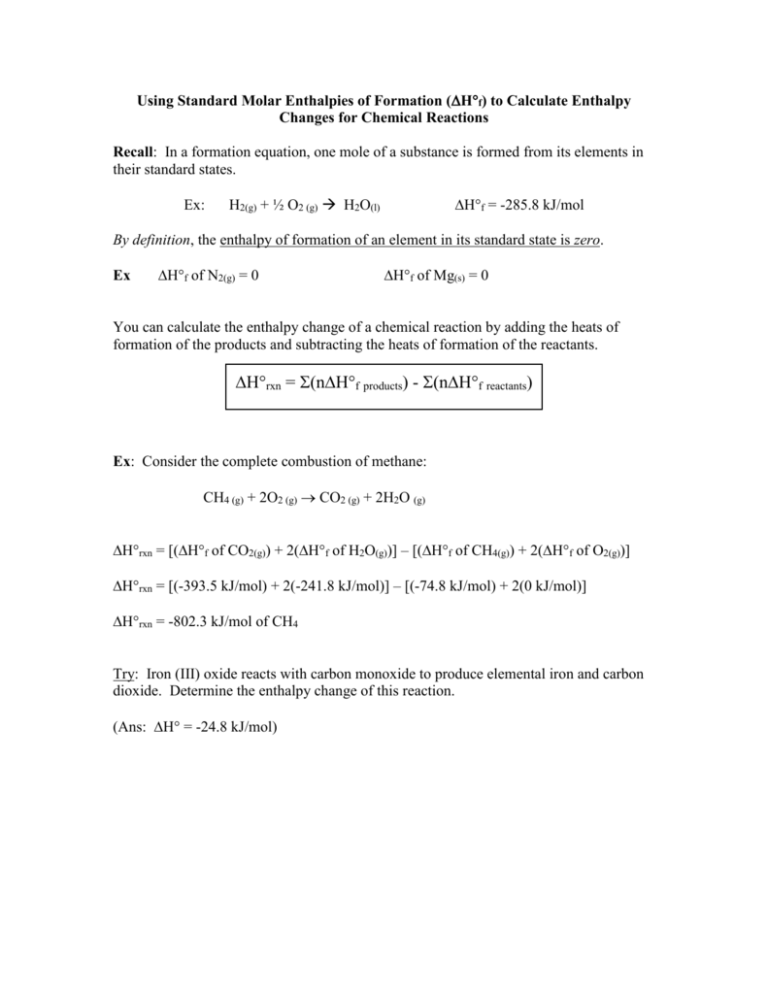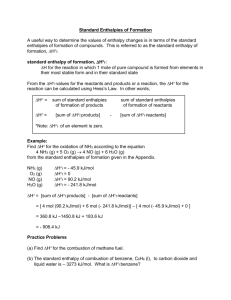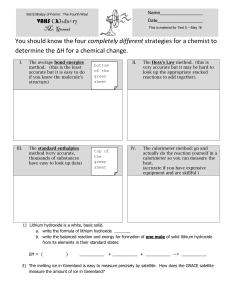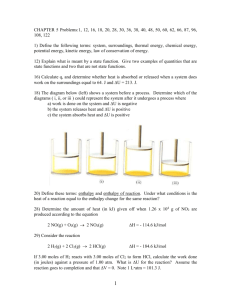Using Standard Molar Enthalpies of Formation to Calculate Enthalpy
advertisement

Using Standard Molar Enthalpies of Formation (Hf) to Calculate Enthalpy Changes for Chemical Reactions Recall: In a formation equation, one mole of a substance is formed from its elements in their standard states. Ex: Hf = -285.8 kJ/mol H2(g) + ½ O2 (g) H2O(l) By definition, the enthalpy of formation of an element in its standard state is zero. Ex Hf of N2(g) = 0 Hf of Mg(s) = 0 You can calculate the enthalpy change of a chemical reaction by adding the heats of formation of the products and subtracting the heats of formation of the reactants. Hrxn = (nHf products) - (nHf reactants) Ex: Consider the complete combustion of methane: CH4 (g) + 2O2 (g) CO2 (g) + 2H2O (g) Hrxn = [(Hf of CO2(g)) + 2(Hf of H2O(g))] – [(Hf of CH4(g)) + 2(Hf of O2(g))] Hrxn = [(-393.5 kJ/mol) + 2(-241.8 kJ/mol)] – [(-74.8 kJ/mol) + 2(0 kJ/mol)] Hrxn = -802.3 kJ/mol of CH4 Try: Iron (III) oxide reacts with carbon monoxide to produce elemental iron and carbon dioxide. Determine the enthalpy change of this reaction. (Ans: H = -24.8 kJ/mol) Using Enthalpies of Formation: Practice 1. Small amounts of oxygen gas can be produced in a laboratory by heating potassium chlorate, KClO3. 2 KClO3 (s) 2KCl (s) + 3 O2 (g) a) Calculate the enthalpy change of this reaction, using enthalpies of formation. b) How much energy is released when 325 g of potassium chlorate is heated? 2. Use the following equation to answer the question below. CH3OH (l) + 3/2 O2 (g) CO2 (g) + 2H2O (g) a) Calculate the enthalpy change of the complete combustion of one mole of methanol, using enthalpies of formation. b) Calculate the enthalpy change for the same reaction using bond energies. How do your answers compare? Using Enthalpies of Formation: Practice 1. Small amounts of oxygen gas can be produced in a laboratory by, KClO3. 2 KClO3 (s) 2KCl (s) + 3 O2 (g) a) Calculate the enthalpy change of this reaction, using enthalpies of formation. b) How much energy is released when 325 g of potassium chlorate is heated? 2. Use the following equation to answer the question below. CH3OH (l) + 3/2 O2 (g) CO2 (g) + 2H2O (g) a) Calculate the enthalpy change of the complete combustion of one mole of methanol, using enthalpies of formation. b) Calculate the enthalpy change for the same reaction using bond energies. How do your answers compare?











